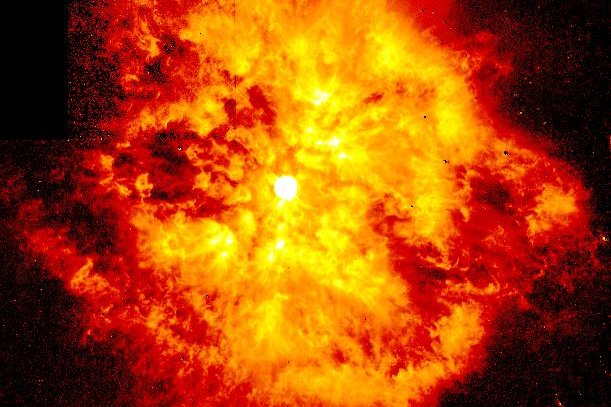A composite of Hubble images shows a star explosion. Photo by NASA
BERKELEY, Calif., May 6 (UPI) -- Scientists say cosmic hotspots, the areas around stars, hosted DNA's chemical precursors -- ultimately enabling the origin of life.
Researchers already knew the basic chemical bonds required to build DNA. Without carbon rings supplemented with nitrogen atoms there is no double helix. These rings make up nucleobases, which are the main building blocks of RNA and DNA.
But how did these nitrogen-enriched molecular rings come about? What environmental conditions enable their genesis?
New research suggests the carbon-rich environment surrounding dying stars was key in the development of life's chemical foundation.
To recreate the life-enabling stellar environs, scientists used what's called a hot nozzle at the Department of Energy's Advanced Light Source facilities inside the Berkeley Lab. The hot nozzle is designed to help scientists hone in on the nuances of chemical reactions at extremely high temperatures. Most recently, the tool helped researchers detail soot formation during the combustion process.
Through the hot nozzle, researchers injected a gas containing a combination of the two basic elements of interest -- a nitrogen-embedded single ringed carbon molecule and two acetylene molecules. Acetylene is a short hydrocarbon and the simplest alkyne.
The high heat of the nozzle (some 700 degrees Kelvin) initiated a series of reactions that resulted in the formation of two nitrogen-containing ring molecules called quinolone and isoquinoline.
The molecules that exited the nozzle were slightly more complex than the two that entered, suggesting the high-energy environments near carbon-rich stars are essential to the chemical reactions that ultimately enabled life.
"There's an energy barrier for this reaction to take place, and you can exceed that barrier near a star or in our experimental setup," Musahid Ahmed, a research scientist in the Chemical Sciences Division at Berkeley Lab, explained in a press release. "This suggests that we can start looking for these molecules around stars now."
Ahmed and his colleagues say once these nitrogen-enriched carbon rings form, the could be blown out into interstellar space by solar winds.
The new research was published in the Astrophysical Journal.















